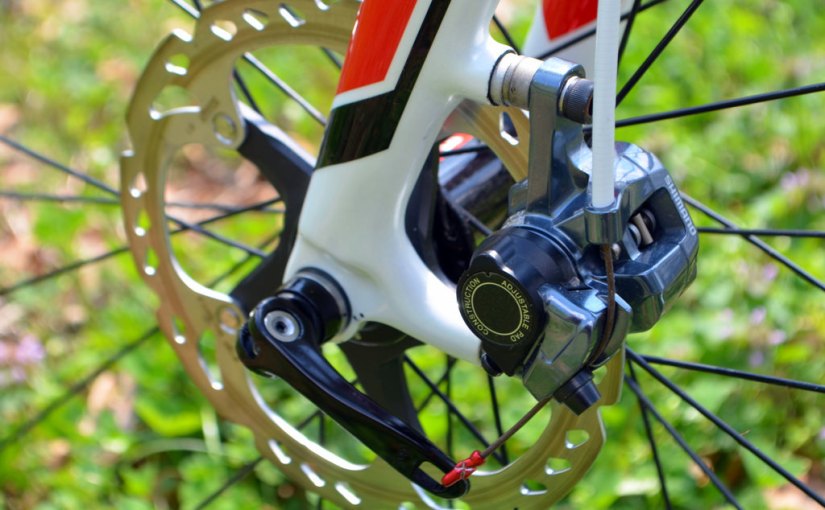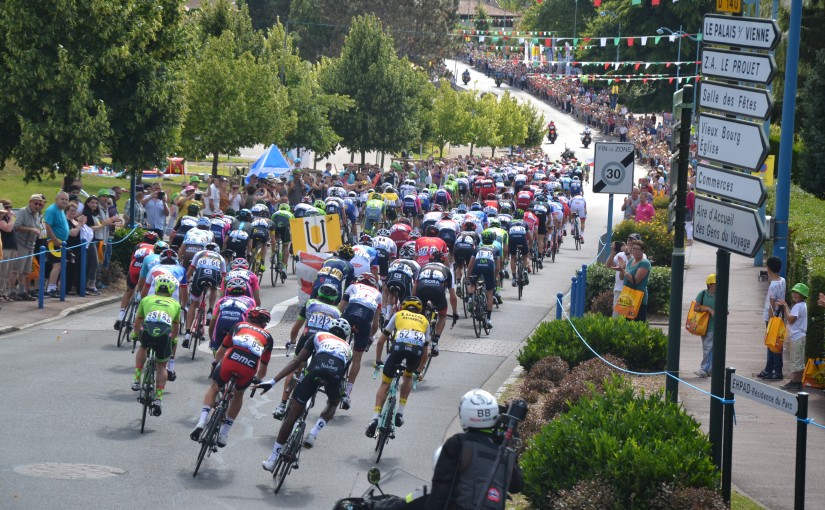The season is already a couple of months old and we’re several races in already but this week has felt like the start of the new term proper. The first couple of stages of Paris Nice and Tirreno Adriatico give the commentators and colour men the chance to ruminate on the riders showing early form and look ahead to the monuments in the coming weeks and slightly further away the Giro. That’s the plan anyway. The peloton and the viewer wants to get played in gently before the GC gets decided over the course of the weekend. Things went awry for some of the key players on the first stage of Paris Nice as the weather intervened and caused time gaps that re-wrote individual’s game plans, Richie Porte just one of many reduced to stage hunting from then on. In Tirreno we saw a whole team derailed, not by the conditions this time. Sky riding with dual leaders in Mikel Landa and Geraint Thomas lost time on the team time trial as their exotic tri spoke wheels wilted in the spring sunshine.
Not the ideal start for riders looking to put down a form marker for Milan San Remo or the grand tours perhaps but it added an additional ingredient to a dish that I always look forward to. With the possible exception of Poland the week long stage races that follow the grand tours just don’t engage me in the way that Paris Nice, Tirreno or Itzulia can. I missed so much of last season as far as catching a stage or one day race ‘live’ was concerned, although so watching this week has felt like the end of Lent and I’m finally able to tick into the good stuff again.
Paris Nice and Tirreno serve up fairly meagre rations if you’re looking for a grand tour primer with only one or two days designed with the climbers in mind. There’s normally enough on the bone for a GC rider to claim the overall but if the queen stage does succumb to the weather then you end up with results like last year’s Tirreno where Greg Van Avermaet ended up with Neptune’s trident. The one rider who I could imagine overcoming the grand tour specialists without needing rain to stop play is Peter Sagan. With two stages remaining Sagan already has two of the proceeding ones chalked up. On Sunday he managed to stay with Thomas and race leader to Nairo Quintana to take the second. Mark Cavendish (fairly anonymous in the same race as I write) may grab more of the headlines if he matches Eddy Merckx’s Tour stage wins record but Sagan has to be the closest we have to The Cannibal in today’s peloton. With Cancellara out of the picture I can see Sagan really dominating the next few years of classics racing even if he’ll never approach Merckx for all round ability. Thing is though I resent Sagan’s apparent superiority. If he’s made the final selection I find myself frantically scanning the other riders, carrying out a mental tick box assessment of who might be capable of beating him to the line. A couple of weeks ago, the ‘opening weekend’ of Het Nieuswblad and Kuurne Brussel Kuurne Sagan inevitably had been there at the death, winning the latter and placing second to Van Avermaet the previous day. I’m not quite at the point where I can’t find any joy in a Sagan victory, I just prefer the unpredictability, the ‘not knowing’ when the favourite is missing.
If there’s such a thing in cycling and if it’s not ironic to bestow it on him Alberto Comtador was the moral winner of Paris Nice. He’d ridden into contention during the week and was snapping at Sergio Henao’s heels after the Sky rider had assumed the yellow on Saturday. Henao wouldn’t have been my obvious choice for team principal but with Thomas and Landa in Italy he got the nod. Paris Nice isn’t a race that Chris Froome tends to do, although he has cropped up for Tirreno in the past. Froome involvement in this year’s race was limited to selfies as the peloton swept past on his local training routes. Contador was gracious in defeat (by two.. count them.. seconds!) to a rider that I can’t imagine leading Sly in a grand tour anytime soon. Fair enough, that Henao caught up enough to snatch the yellow back from him but I don’t think it would have happened if the peloton hadn’t worked as hard as it did to chase down Contador’s breakaway.
With Froome laser focused on the Tour again Sky have to ‘make do’ with someone else to lead the team and there’s something of a ‘Where’s Wally?’ element to the odd appearance he makes on social media. Make no mistake though, even when he isn’t racing Froome is the principal rider on Team Sky in the eyes of the fans and the media. As the teams own Watergate has rumbled on since last year’s initial TUE expose Froome has been conspicuous by his absence particularly in a week that saw more than half of his teammates come out publicly in support of Dave Brailsford. A combination of published and leaked reports on the TUE saga and investigations into the culture at British Cycling had led to a swathe of opinion that Brailsford needed to go. A rumour in the press that a rider within Sky had said that Brailsford should resign triggered the votes of confidence voiced on social media by Thomas and others. A follow up piece in the papers listed the riders who hadn’t spoken up for their boss. While some were pretty much invisible, such is the irregularity of their social media presence Froome was an obvious omission.* He has shared his view about the TUE saga once or twice. Never one to miss an opportunity to stick the knife into Wiggins he had been as pointed in his criticism as someone who has also ‘benefited’ from a TUE can be. In a tetchy interview recorded during a training camp earlier in the year Froome had also made clear his feelings that Brailsford should be the one with the explaining to do. Going for his fourth TDF title Froome won’t appreciate the distraction if the situation has been resolved by the summer. The inflated media prescence and the partisan nature of the crowds could prove to be an unwelcome distraction if the story refuses to go away. So was he the source of the ‘Brailsford must go’ rumour. In the absence of anything to the contrary it’s tempting to think he might have been. There doesn’t appear to be any doubt that Sky is Brailsford’s team rather than Froome’s but the rider can be characterised as someone who does what’s best for him so it might be tempting to imagine a world where doping questions disappear along with a Brailsford departure. Will Brailsford actually depart is another question entirely. Right at this moment I think not but further revelations might change that and the story shows no sign of going away. In the end it may prove to be ‘noises off’ from the sponsor (notably silent so far) that forces the issue rather than any press clamour that ends the fairytale.
While Sky could celebrate another overall victory in Paris Nice the ‘wheels coming off’ was the perfect phrase to sum up their situation in Tirreno. Pride was somewhat restored by Thomas taking a stage and he’ll finish high on GC albeit a long way off Nairo Quintana. In Abu Dhabi a couple of weeks ago another Sky rider appeared to fall victim to another bit of new technology in the peloton. The introduction of disc brakes is the irresistible force currently buffeting the immovable object of (most of) the riders. New to Sky this year Owain Doull has a gold medal from Rio and some impressive showings in bunch sprints last season under his belt as he becomes the latest prospect hoping to prosper on the Death Star. Doull had a coming together with Marcel Kittel in the final of a stage and sparked another ‘discs are dangerous’ debate when he suggested Kittel’s disc had sliced open his shoe in the ensuing crash. In the aftermath it was pretty conclusively proven that it the only way Kittel’s disc could have come anywhere near Doull’s shoe would have been if Kittel had been on Doull’s left rather than his right and travelling backwards at the time. As this truth was still getting its (ahem) boots on the anti disc faction had already dished up several versions of a potential disc rotor induced end of days.
The problem for the disc brake lobby, i.e the bike companies is that the majority of the riders just don’t want to ride them. I’m not convinced by the safety argument but as no one seems to want to call the pros out on stories like Doull’s or the other disc / not disc crash in last year’s Paris Roubaix the ‘alternative fact’ that disc brakes are too dangerous to be raced is allowed to gain currency. Maybe Doull and whoever that Movistar domestique was that crashed in the Arenberg last year genuinely feel their injuries were caused by discs but the evidence would suggest that disc brakes are some way down the list of potential dangers. Maybe there’s a ‘Rules’ / Velominati element to all of this. Perhaps it’s an old school thing like not wearing white bibs or the correct sock length. There’s little point in trying to enforce discs on the peloton but it will be annoying the hell out of Specialized that their master plan to have us all shelling out an extra few hundred large for discs might be derailed by the rider lobby. So far it’s only Quick Step and Cannondale who have really pushed the disc thing this season. Tom Boonen has done a puff piece about how it would be ‘stupid’ to ignore the benefits (smart guy Tom) and Cannondale had the whole team on discs in Andulucia and had disc equipped TT bikes at Tirreno. At least Sky couldn’t blame the disintegrating wheels on discs.
* Rather like my last post this one came together over a couple of days. On Monday Froome released a statement ‘backing’ Brailsford. I only read one report rather than his full statement but based on the quotes lifted for the article it didn’t sound as if Froome was offering unequivocal support.












